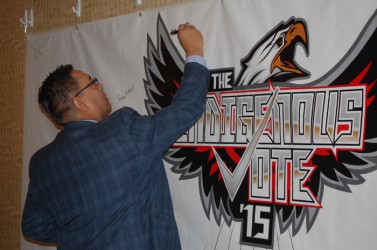Article Origin
Volume
Issue
Year
The numbers won’t be in until the New Year, but the stories support strongly an increase in Aboriginal voting across the country, both on reserves and in urban centres.
“I would venture to say it would be significantly higher that it’s been in previous years,” said Dwight Dorey, National Chief with the Congress of Aboriginal Peoples, which represents Indigenous populations in the urban centres.
“A lot of people took advantage of the advance polls. The percentage was quite high right across the board and my assumption would be, particularly in urban areas, it would be reflective in the urban Aboriginal population getting out to vote.”
The Inuit population was the same, said Natan Obed, president of the Inuit Tapiriit Kanatami, noting that the voting numbers in Nunavut were up.
“The Inuit across Canada seem like they’re excited,” he said. “They have a bit of optimism and hope.”
First Nations people across the country were also excited about the election, said Assembly of First Nations National Chief Perry Bellegarde, and there was more dialogue.
“I believe (the numbers) have gone up but we’re going to have to wait to do the assessment,” he said. “In my opinion right now, I would probably suggest that it did go up.”
In 2011, only 44 per cent of Aboriginal voters marked ballots.
This time around, there is no lack of anecdotal evidence to back up the leaders’ beliefs that numbers are higher.
Manitoba Keewatinowi Okimakanak Grand Chief Sheila North Wilson estimated that voting increased as much as 20 per cent in some ridings in that province.
According to numbers provided by Nishnawbe-Aski Nation, in the 2011 election about 25,000 votes were cast in Kenora, but this time there were nearly 30,700 and 2,909 can be attributed to First Nation votes.
At Cold Lake First Nation in Alberta, a record 355 members cast their ballots, said Chief Bernice Martial in a news release.
A handful of polling stations in Ontario, Manitoba, Saskatchewan and Alberta First Nations ran out of ballots in the late afternoon and early evening. In some cases, ballots were photocopied and in other cases, ballots were collected from other nearby polling stations.
“No electors lost their right to vote in respect to any delays surrounding ballot questions or ballot matters,” said John Enright, spokesperson with Elections Canada. “You can’t anticipate ebbs or flows at a polling station.”
Enright says Elections Canada will be doing an assessment of the election as usual, but there won’t be any numbers available until January.
Prior to the Oct. 19 federal election, which saw Justin Trudeau’s Liberals swept into power, the AFN released a report identifying 51 ridings in which Indigenous voters could have an impact. Of those ridings, there were 24 wins for the Liberals, including 17 gains, nine wins for the Conservatives, 16 for the NDP, and two for the Bloc Québécois.
Bellegarde won’t say whether a Conservative defeat in those 51 ridings meant Indigenous people carried the vote.
“We were there to mobilize the vote. We weren’t there to jump on any particular party but we wanted our people to make an informed choice,” said Bellegarde. “And I believe it did matter in those key ridings where large numbers of First Nations people turned out to vote.”
Having a higher number of Indigenous people vote was no accident. Rallies and intensive social media campaigns encouraged the effort.
Cara Currie Hall, originally from Maskwacis and now living in the United States, was a force behind the Indigenous vote in the U.S. for the past two Obama elections. She returned home in October to do the same thing here.
“Rock the Indigenous Vote is a movement of the people by the people to get out the vote for the federal election and to really make a difference and be the swing vote,” said Currie Hall.
AFN British Columbia Regional Chief Shane Gottfriedson said it was important to get Indigenous people mobilized, something that is still fresh considering First Nations were only given the right to vote in 1960.
“(This) is for a better quality of life,” said Gottfriedson. “We’re not just mom and pop band office operations anymore. Some of the communities across this country are multi-million dollar businesses that they run. Our people are the fastest growing population in Canada. I think our young people now, even in band elections, are the majority of the votes, so we really are encouraging all our young people in Indian country to get out and vote and they are.”
Photo option: Shane Gottfriedson, Assembly of First Nations British Columbia Regional Chief, signed his name on the banner “Rock the Indigenous Vote” at the open forum held on the Enoch Cree Nation.
- 2505 views

